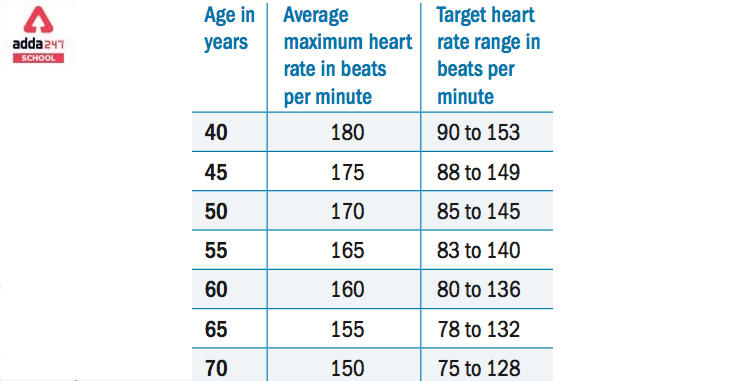Normal Heart Rate
The heart is a very important organ of the human body. Pulse and Normal Heart Rate is an important measure of health. A pulse is a tactile arterial palpation of the cardiac cycle (heartbeat) by educated fingertips in medicine. The Normal Heart Rate can be used to assess overall cardiovascular health and fitness. Although lower is generally better, bradycardias can be dangerous. Weakness, loss of energy, and fainting are all signs of a dangerously slow heartbeat.
In this article, we will know about Normal Heart Rate in detail.
Read: Solar System
Heart Rate Normal in Oximeter
Pulse is the tactile arterial palpation of the heartbeat, and it can be felt at any location where an artery can be compressed near the body’s surface. Pulse is the same thing as monitoring heart rate. Auscultation, which is normally measured with a stethoscope, can also be used to determine the heart rate by simply listening to the heartbeat. Three fingers are typically used to measure the radial pulse. The pulse pressure is occluded with the finger nearest to the heart. A rough estimate of blood pressure is obtained using the middle finger. The most distal finger from the heart is utilized to cancel out the ulnar pulse’s influence. Sphygmology is the science of studying the pulse. In Coronavirus, the heart rate normal will be more than 100.
Read: Photosynthesis
Normal Heart Rate for Women & Mens
Normal heart rate for women and men should have a resting heart rate of 60 to 100 beats per minute.
In general, a lower resting heart rate indicates better cardiac function and cardiovascular fitness. A well-trained athlete, for example, would have a resting heart rate closer to 40 beats per minute.
Simply take your pulse to determine your heart rate. Place your index and third fingers on the side of your windpipe on your neck. Place two fingers between the bone and the tendon above your radial artery, which is on the thumb side of your wrist, to check your pulse. Count the number of beats in 15 seconds when you feel your pulse. Calculate your beats per minute by multiplying this amount by four.
There is a wide range of normal heartbeats depending upon various factors. However, a heart rate that is excessively high or low could suggest a problem. If your resting heart rate is consistently greater than 100 beats per minute (tachycardia), or if you’re not a trained athlete and your resting heart rate is less than 60 beats per minute (bradycardia), see your doctor, especially if you have other signs or symptoms like fainting, dizziness, or shortness of breath.
Read: Digestive System of human
Heart Rate Normal Range
There are various factors on which the heart rate normal range of an individual depends. The heart rate is influenced by a variety of factors, including:
- Age
- Position of the body (standing up or lying down, for example)
- Emotions
- Fitness and activity levels as you become older
- Being a cigarette smoker
- Temperature of the air
- Having a heart condition, excessive cholesterol, or diabetes
- Medications based on body size
Below is a chart of Normal Pulse Rates on the age factor:
| newborn (0–3 months old) |
infants (3 – 6 months) |
infants (6 – 12 months) |
children (1 – 10 years) |
children over 10 years & adults, including seniors |
well-trained adult athletes |
|---|---|---|---|---|---|
| 99-149 | 89–119 | 79-119 | 69–129 | 59–99 | 39–59 |
Normal Heart Beat Rhythm
The normal heart beat rhythm and force of a normal pulse are both consistent. Sinus arrhythmia, ectopic beats, atrial fibrillation, paroxysmal atrial tachycardia, atrial flutter, partial heart block, and other conditions can cause an erratic pulse. The term “intermittent pulse” refers to the dropping out of beats at pulse on a regular basis. Pulsus bigeminus and second-degree atrioventricular block are examples of regular intermittent (regularly irregular) pulses. Atrial fibrillation is an example of an irregular intermittent (irregularly irregular) pulse.
Read: Scientific Name of Pig
Normal Heart Rate Force
Also known as pulse compressibility. It’s a rough way of calculating systolic blood pressure.
Normal Heart Rate Tension
It is the same as diastolic blood pressure. The vessel is soft or impalpable between beats, indicating a low tension pulse (pulsus mollis). Even between pulse beats, vessels in a high-tension pulse (pulsus durus) feel rigid.
Healthy Heart Rate
A healthy Heart Rate is 72 beats per min. Palpatory arteriogram estimate is based on the shape or contour of a pulse. Aortic regurgitation is characterised by a rapid rising and falling pulse (pulsus celer). Aortic stenosis is characterised by a sluggish rising and falling pulse (pulsus tardus).
Comparing pulses from various locations provides useful clinical information.
An abnormal or aberrant artery course, coarctation of the aorta, aortitis, dissecting aneurysm, peripheral embolism, and other conditions can cause a discrepant or uneven pulse between the left and right radial arteries. Coarctation to the aorta, aortitis, block at the bifurcation of the aorta, dissection of the aorta, iatrogenic trauma, and arteriosclerotic blockage all cause an uneven pulse between the upper and lower extremities.
Pulse Normal Range: Condition of the arterial wall
Pulse Normal Range: After digital pressure flattens an artery, it is no longer palpable. Arteriosclerosis is indicated by a thick radial artery perceptible 7.5–10 cm up the forearm.
Normal Pulse Rate: Radio-femoral delay
The femoral pulse may be greatly delayed in coarctation of the aorta as compared to the radial pulse (unless there is coexisting aortic regurgitation). In supravalvar aortic stenosis, the delay is also visible.
Normal Pulse Rate: Volume
The volume of an artery refers to how much it expands during diastolic and systolic states. It’s also known as pulse amplitude, expansion, or size.









 DTE Maharashtra Polytechnic Merit List 2...
DTE Maharashtra Polytechnic Merit List 2...
 How Normalisation Influence CUET Score 2...
How Normalisation Influence CUET Score 2...
 CUET Result 2025 OUT SHORTLY @cuet.nta.n...
CUET Result 2025 OUT SHORTLY @cuet.nta.n...









